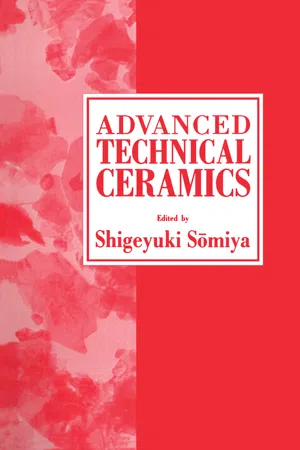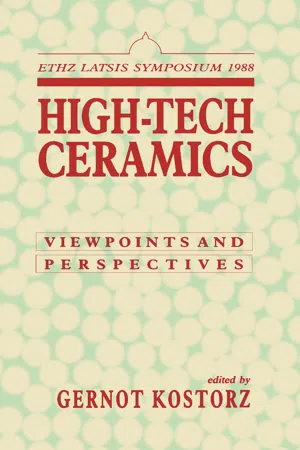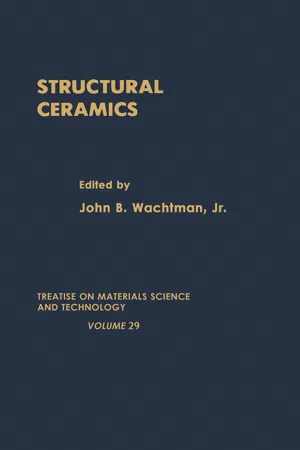Technology & Engineering
Applications of Ceramics
Ceramics are used in a wide range of applications, including in the production of pottery, bricks, tiles, and glass. In engineering, ceramics are valued for their high-temperature resistance, electrical insulation properties, and hardness, making them suitable for use in manufacturing processes, electronics, and structural components such as turbine blades and cutting tools.
Written by Perlego with AI-assistance
Related key terms
1 of 5
9 Key excerpts on "Applications of Ceramics"
- eBook - PDF
- Shigeyuki Somiya(Author)
- 2012(Publication Date)
- Academic Press(Publisher)
Thus, engineering ceramics is a subset of tech-nical ceramics, including principally ceramics with superior mechanical properties, such as great strength, abrasion resistance, a high level of elasticity, enhanced hardness, heat resistance, and lubricating ability. These ceramics have found applications in ceramic engines, cutting tools, grinding materials, and materials for bearings. Advanced ceramics or high-technology ceramics is used for many of the same materials and products as technical ceramics. These terms, however, particularly emphasize the special value or advanced features which height-en the commercial value of technical ceramics. Like engineering ceramics and technical ceramics, they are general designations for ceramics used in industrial applications. Structural ceramics are used as structural parts in machines. They in-clude engine parts, cutting tools, and seals. Bioceramics are, as the name indicates, ceramics used in biological applications, such as artificial teeth or bones. Electroceramics are suitable for use as insulators for electric line or in electrical components. Electronic ceramics, however, are ceramics used in the electronics field, including dielectric substances, magnetic sub-stances, and semiconductors. Hydrothermal ceramics are powders, single crystals, sintered sub-stances, and thin membranes formed in a vessel resistant to high tempera-tures and pressures (an autoclave, for instance) under high-pressure and high-temperature conditions with pure water, aqueous solutions, organic solvents, and/or nonaqueous solvents. The powders, single crystals, sin-tered substances, and thin films used under those conditions are also called hydrothermal ceramics. Recently, the use of polymers such as SiC as precursor materials for ceramics has led to a strong demand for high-performance ceramics. Be-cause of their enhanced features, these ceramics are called high-performance ceramics, active ceramics or high-value-added ceramics. - George Murray(Author)
- 1997(Publication Date)
- CRC Press(Publisher)
11 Selection of Ceramic Materials and Their Applications 1 INTRODUCTION lsa Bar-On and R. Nathan Katz Worcester Polytechnic Institute Worcester, Massachusetts During the past several decades high-perfonnance ceramics have emerged as ena-bling materials for many key technologies. Examples of where a property, or more usually the combination of several properties, of modern ceramics have been en-abling include fiber optic data transmission based on low-optical-loss glass fibers; high-perfonnance electronic packages based on the combination of dielectric con-stant, thennal conductivity and thennal expansion of ceramics such as aluminum oxide or aluminum nitride; advanced cutting tools based upon the hot hardness, chemical inertness, thennal shock resistance and toughness of silicon nitride or SiC whisker-reinforced aluminas. While, as these examples illustrate, ceramics may be chosen for their optical, electrical, magnetic, or mechanical properties, this chapter will focus on those properties of ceramics usually associated with their application as structural or wear components. There are several reasons for this emphasis. First, the readers of this book are most likely to have a mechanical rather than an elec-tronic orientation. Second, the engineering difficulties in applying ceramics as op-tical and, increasingly, as electronic components are most often in areas such as attachment or thennal stresses, which are mechanical design issues. Lastly, the structural (mechanical load bearing) Applications of Ceramics are those projected to grow most rapidly over the next decade [ 1 ]. This chapter will briefly review ceramic processing. Following this, a brief introduction of the probabilistic design procedure utilized in the design of ceramic components (particularly those which will be subjected to tensile stresses) will be presented.- eBook - ePub
Sustainable Construction Materials
Sewage Sludge Ash
- Ravindra K. Dhir OBE, Gurmel S. Ghataora, Ciaran J. Lynn(Authors)
- 2016(Publication Date)
- Woodhead Publishing(Publisher)
Ceramics offer tremendous value in these wide-ranging applications because of their useful thermal, mechanical, electrical and chemical properties. For example, the materials are used extensively in gas turbine engines in aircrafts because of their low thermal conductivity and high temperature stability, in parts such as valves, bearings and pumps because of their high resistance to wear and chemical attack and in bricks because of their high strength and durability properties (Richerson, 2006). The most commonly used raw material in ceramics is clay. The plastic nature of this material when mixed with water is fundamental to the moulding and forming of ceramic products, and combined with the densification the clay undergoes under thermal treatment, leading to greater mechanical properties without loss of form, makes it a very suitable option - eBook - PDF
High-Tech Ceramics
Viewpoints and Perspectives
- Gernot Kostorz(Author)
- 2016(Publication Date)
- Academic Press(Publisher)
11 Medical Applications of Ceramics WOLFHART RIEGER Metoxit AG, CH-8240 Thayngen, Switzerland INTRODUCTION Ceramic materials have seen a rapid development in the past 20 years. New materials for new applications have emerged, are produced, marketed and employed in numerous fields. Though by volume still a small fraction in the materials world, ceramics are making important contributions to the development of new solutions to old problems. This is not the place to discuss extensively the various applications of advanced ceramic materials. It is well known, however, that a new field of structural applications has emerged in the past two decades with encouraging results: the field of applications in medicine. Among the materials that are used in medicine, i.e. as surgical implants, are metals, plastics, textiles, rubber and ceramics. Biomaterials, in general can be defined as (La Revue, 1987): (1) materials for long-term implantation in human tissue, such as arterial and dental prostheses, prostheses of organs (heart, blood vessels), and artificial joints (hip, knee); (2) products for prolonged contact with vessels and tissue or bone; (3) products for short-term contact with tissue or bone such as probes or instruments for tests and inspection; (4) materials for obtaining and storing blood and blood plasmas; (5) products used as instruments and tools during surgery. Overall, biomaterials can be classified as 'solid, soluble or insoluble, degradable or non-degradable products for short- or long-term contact with human biological structures'. HIGH-TECH CERAMICS: VIEWPOINTS Copyright © 1989 Academic Press Limited AND PERSPECTIVES ISBN 0-12-421950-0 All rights of reproduction in any form reserved. - eBook - PDF
Metals and Materials
Science, Processes, Applications
- R. E. Smallman, R J Bishop(Authors)
- 2013(Publication Date)
- Butterworth-Heinemann(Publisher)
These will be our prime concern. Their introduction as engineering components in recent years has been based upon considerable scientific effort and has revolutionized engineering design practice. In general, the development of engineering ceramics has been stimulated by the drive towards higher, more energy-efficient, process temperatures and foreseeable shortages of strategic minerals. In contrast to traditional ceramics, which use naturally-occurring and, inevitably, rather variable minerals, the new generation of engineering ceramics depends upon the availability of purified and synthesized materials and upon close microstructural control during processing. Ceramics are subject to variabil-ity in their properties and statistical concepts often need to be incorporated into design procedures for stressed components. Design must recognize the inherent brittleness, or low resistance to crack propagation, and modify, if necessary, the mode of failure. Ceramics, because of their unique proper-ties, show great promise as engineering materials but, in practice, their production on a commercial scale in specified forms with repeatable properties is often beset with many problems. Using chemical composition as a basis, it is possi-ble to classify ceramics into five main categories: 1. Oxides - alumina, A1 2 0 3 (spark plug insulators, grinding wheel grits), magnesia, MgO (refractory linings of furnaces, crucibles), zirconia, Zr0 2 (piston caps, refractory lining of glass tank furnaces), zirconia/alumina (grinding media), spinels, M 2+ O.M 3+ 2 0 3 (ferrites, magnets, transis-tors, recording tape), 'fused' silica glass ( labora-tory ware), 2. Carbides - silicon carbide, SiC (chemical plant, crucibles, ceramic armour), silicon nitride, Si 3 N 4 (spouts for molten aluminium, high-temperature bearings), boron nitride, BN (crucibles, grinding wheels for high-strength steels). 3. Silicates - porcelain (electrical components), steatites (insulators), mullite (refractories). - eBook - PDF
- John Jr. Wachtman(Author)
- 2012(Publication Date)
- Academic Press(Publisher)
TREATISE ON MATERIALS SCIENCE AND TECHNOLOGY, VOL. 29 1 Opportunities and Prospects for the Application of Structural Ceramics R. NATHAN KATZ Army Materials Technology Laboratory Watertown, MA I. Introductio n1 II . Ceramic s i n Hea t Engines 4 A. Ceramic s fo r Diesel-Engine Applications5 B. Applicatio n o f Ceramics i n Ga s Turbine s 1 0 III . Bearing s 1 5 IV . Ceramic s fo r Meta l Shaping 1 7 V. Industria l Wea r Part s 1 8 VI . Bioceramics 2 0 VII . Militar y Ceramic s 2 1 VIII . Implication s o f High-Performance Structura l Ceramic s 2 3 Reference s 2 5 I. Introductio n Modern high-performance ceramics are the enabling materials for many advanced technologies. Electronics, telecommunications, optical systems, sensors, catalysts, bone replacements, heat exchangers, heat engines, and metal-shaping equipment are all either benefiting from or projected to benefit from advanced ceramic materials. This chapter will focus on the applications for high-performance structural ceramics—materials that combine the tradi-tional advantages of ceramics (chemical inertness, high-temperature capabili-ty, and hardness) with the ability to carry a significant tensile stress. The payoff to society from the utilization of structural ceramics is potentially large. Table I lists some of the performance benefits that have been demonstrated to be attainable for typical applications. The fuel savings from the adiabatic diesel engine are projected to be as large as $5 billion in the United States alone (Katz 1980). Additionally, the utilization of relatively ι Copyrigh t© 198 9 b y Academic Press, Inc . Allrights o f reproduction i n an y for m reserved. ISBN 0-12-341829- 1 - eBook - PDF
Engineering Materials
Research, Applications and Advances
- K.M. Gupta(Author)
- 2014(Publication Date)
- CRC Press(Publisher)
78 Engineering Materials: Research, Applications and Advances 4.2 Types of Ceramics Ceramics may broadly be classified under various groups. Main among them are the following: 1. Refractories 2. Silicates 3. Glasses 4. Limes 5. Cements 6. Plain concretes 7. Prestressed concretes 8. Rocks and stones 9. Reinforced cement concrete (RCC) 10. Abrasives 11. Clay and clay products: bricks, tiles, etc. Carbides of tungsten, titanium, zirconium, silicon, alkali halides and sili-con nitride (Si 3 N 4 ) are some important ceramic materials of present time. An exhaustive list of ceramics is given in Table 4.1 with their related details and applications. 4.3 Refractories Refractories are ceramic materials of specific nature which are capable of withstanding high temperatures. Commercial refractories are made of com-plex solid oxides of elements such as silicon, aluminium, magnesium, cal-cium and zirconium. Refractories confine the heat in ovens and furnaces by preventing heat loss to the atmosphere. Refractories are unaffected by high temperatures. They are expected to resist mechanical abrasion, infusion of molten metals, slag or metallic vapours and also the action of superheated steam, sulphurous oxide, chlorine and other gases. Examples : One of the most widely used refractories is based on alumina– silica composition, varying from nearly pure silica to nearly pure alumina. Other common refractories are silica, magnesite, forsterite, dolomite, silicon carbide and zircon. 79 Structures and Applications of Ceramics, Refractories and Glasses, etc. TABLE 4.1 Ceramics, Their Related Details and Applications S. - William D. Callister, Jr., David G. Rethwisch(Authors)
- 2020(Publication Date)
- Wiley(Publisher)
One chief concern in the application of ceramic materials is the method of fabrication. Many of the metal-forming operations discussed in Chapter 11 rely on casting and/or techniques that involve some form of plastic deformation. Because ceramic materials have rel- atively high melting temperatures, casting them is normally impractical. Furthermore, in most instances the brittleness of these materials precludes deformation. Some ceramic pieces are formed from powders (or particulate collections) that must ultimately be dried and fired. Glass shapes are formed at elevated temperatures from a fluid mass that becomes very viscous upon cooling. Cements are shaped by placing into forms a fluid paste that hardens and assumes a permanent set by virtue of chemical reactions. A taxonomical scheme for the several types of ceramic-forming techniques is presented in Figure 13.12. Fabrication and Processing of Ceramics Glass-forming processes Particulate-forming processes Cementation Pressing Blowing Drawing Fiber forming Powder pressing Hydroplastic forming Slip casting Tape casting 3D Printing Hot Uniaxial Isostatic Drying Firing Ceramic fabrication techniques Figure 13.12 A classification scheme for the ceramic- forming techniques discussed in this chapter. 494 • Chapter 13 / Applications and Processing of Ceramics Glass Properties Before we discuss specific glass-forming techniques, some of the temperature-sensitive properties of glass materials must be presented. Glassy, or noncrystalline, materials do not solidify in the same sense as do those that are crystalline. Upon cooling, a glass becomes more and more viscous in a continuous manner with decreasing temperature; there is no definite temperature at which the liquid transforms into a solid as with crystalline materials.- eBook - PDF
Materials Science and Engineering, P-eBK
An Introduction
- William D. Callister, Jr., David G. Rethwisch, Aaron Blicblau, Kiara Bruggeman, Michael Cortie, John Long, Judy Hart, Ross Marceau, Ryan Mitchell, Reza Parvizi, David Rubin De Celis Leal, Steven Babaniaris, Subrat Das, Thomas Dorin, Ajay Mahato, Julius Orwa(Authors)
- 2020(Publication Date)
- Wiley(Publisher)
CHAPTER 13 Applications and processing of ceramics 409 SUMMARY GLASSES • The familiar glass materials are noncrystalline silicates that con- tain other oxides. In addition to silica (SiO 2 ), the two other primary ingredients of a typical soda–lime glass are soda (Na 2 O) and lime (CaO). GLASS‐CERAMICS • Glass‐ceramics are initially fabricated as glasses and then, by heat treatment, crystallised to form fine‐grained polycrystalline materials. • Two properties of glass‐ceramics that make them superior to glass are improved mechanical strengths and lower coefficients of thermal expansion (which improves thermal shock resistance). CLAY PRODUCTS • Clay is the principal component of whitewares (e.g. pottery and tableware) and structural clay products (e.g. building bricks and tiles). Ingredients (in addition to clay) may be added, such as feldspar and quartz; these influence changes that occur during firing. REFRACTORIES • Materials that are employed at elevated temperatures and often in reactive environments are termed refractory ceramics. • Requirements for this class of materials include high melting tem- perature, the ability to remain unreactive and inert when exposed to severe environments (often at elevated temperatures), and the ability to provide thermal insulation. • Common refractory ceramic materials include the following: fire- clay, high‐alumina, extra‐high alumina, silica, periclase (high MgO content), zircon (zirconium silicate), and silicon carbide. ABRASIVES • The abrasive ceramics are used to cut, grind, and polish other softer materials. • This group of materials must be hard and tough and be able to withstand high temperatures that arise from frictional forces. • Two classifications of ceramic abrasive ceramics are naturally occurring and manufactured. Those that occur naturally include diamond, corundum (Al 2 O 3 ), emery, garnet, and sand.
Index pages curate the most relevant extracts from our library of academic textbooks. They’ve been created using an in-house natural language model (NLM), each adding context and meaning to key research topics.








